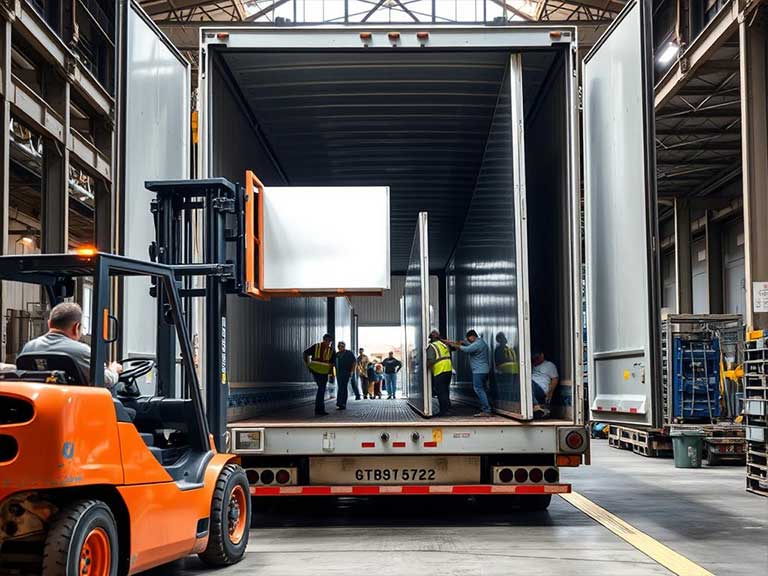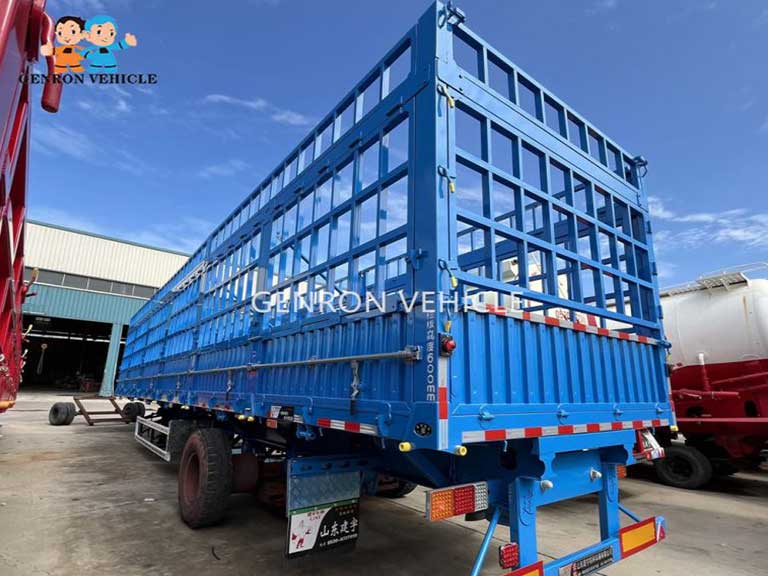Are you transporting cargo safely and efficiently with your sidewall semi-trailer? It’s key to load it right to avoid damage and accidents. At Genron International Trade, we know how to load for safety and efficiency.
We make semi-trailers, including fuel tanker trailers, low-bed semi trailer, flatbed semi trailer, and end dump trailers. We’ve got guidelines to help you load better. We’ll talk about weight, cargo placement, and securing to keep your goods safe.
Our advice can protect your cargo and make your trailer last longer. Whether you’re in Africa, Southeast Asia, or elsewhere, our knowledge will help you meet your transport goals.
Table of Contents
Preparing Your Sidewall Semi-Trailer for Loading
Before you load your sidewall semi-trailer, get it ready for safe transport. At Genron International Trade, we know how important preparation is.
Selecting a Level Surface for Parking
Park your trailer on a level surface for stability. An uneven surface can make the trailer tilt, leading to accidents or cargo damage. Always check the surface before loading to keep the trailer stable.
Conducting a Pre-Loading Inspection
Inspect your trailer before loading. Look for damage or wear on the walls and floor. Make sure all locks work to secure the cargo. A good inspection prevents transport problems and keeps cargo safe.
Gathering Necessary Equipment and Tools
Right equipment is key for safe and efficient loading. You’ll need straps, load bars, and dunnage for your cargo. For heavy loads, use a forklift or pallet jack. The right tools help distribute weight and secure cargo.
| Preparation Task | Importance | Tools/Equipment |
| Parking on a Level Surface | High | Level Indicator |
| Pre-Loading Inspection | High | Inspection Checklist |
| Gathering Equipment | Medium | Straps, Load Bars, Dunnage |
By preparing well, you can avoid loading and transport problems. Our Genron semi-trailers are built strong, but regular checks are still vital for the best performance.

Understanding Proper Cargo Distribution and Weight Management
At Genron International Trade, we say the secret to safe semi-trailer transport is in cargo distribution and weight management. It’s all about keeping your cargo safe and avoiding accidents and trailer damage.
The 60/40 Weight Distribution Rule
The 60/40 weight rule is crucial for balance during transport. It means putting 60% of the cargo weight at the front and 40% at the rear. This prevents trailer sway and handling issues from uneven weight.
Calculating Maximum Load Weight Capacity
Before you begin loading the trailer, find out the maximum weight capacity of the sidewall trailer. Going over this can damage the trailer’s walls and put everyone’s safety at risk. Our Genron semi-trailers are built with specific weight limits. Never go over these, even if the walls look strong.
Ensuring Even Axle Load Distribution
It’s important to spread the weight evenly on your trailer’s axles. Use scales to check the weight on each axle. Too much weight on one axle can cause mechanical problems and get you in trouble with the law.
Here’s a quick guide to proper cargo distribution and weight management:
| Aspect | Description | Benefit |
| 60/40 Weight Distribution | 60% cargo weight at the front, 40% at the rear | Maintains balance, prevents trailer sway |
| Maximum Load Weight Capacity | Calculate and adhere to the trailer’s GVWR | Prevents overloading, structural damage |
| Axle Load Distribution | Evenly distribute weight across all axles | Prevents excessive strain, mechanical failures |

Step-by-Step Guide to Loading a Sidewall Semi-Trailer
At Genron International Trade, we teach a step-by-step method for loading semi-trailers. It’s not just about filling it up. It’s about doing it right to keep your goods safe during transport.
Loading Heavy Items First: The Foundation Principle
Start with the heaviest items at the bottom and center of the trailer. This creates a solid base that makes the trailer stable and reduces tipping risk. It’s key for keeping the center of gravity low, which makes transport safer.
- Start with the heaviest items at the bottom and center of your sidewall semi-trailer.
- Make sure the weight is spread out evenly to stop cargo from shifting during transport.
Proper Stacking Techniques for Different Cargo Types
Proper stacking is crucial for keeping cargo and trailer walls safe. For palletized cargo, spread the weight evenly, like 800 lbs/foot, to stop it from moving. Our Genron trailers have strong walls for support, but stacking right is still key.
| Cargo Type | Stacking Technique | Benefits |
| Palletized Cargo | Even distribution, 800 lbs/foot standard | Prevents cargo movement, reduces gaps |
| Mixed Cargo | Tiers with heavier items at the bottom | Enhances stability, reduces risk of damage |
| Specialized Cargo | Customized loading based on cargo shape and size | Maximizes trailer space, ensures safe transport |
Filling Gaps and Preventing Cargo Movement
Filling gaps between the cargo and the trailer walls is key to stopping cargo shift. Use small items or dunnage to fill these gaps. This makes the load solid and stops it from moving. It’s vital to avoid damage and safety problems during transport.
- Use smaller items or dunnage material to fill gaps between larger cargo pieces and the trailer walls.
- Ensure that all cargo is securely positioned to prevent movement during transit.
By following these steps and properly loading your sidewall semi-trailer, you can lower the risk of cargo damage. This ensures a safe transport process.

Securing Your Load and Transport Safety Measures
At Genron International Trade, we know load security is key for safe transport. Our semi-trailers are made with safety in mind, having many anchor points for securing cargo. Securing your load correctly is key to preventing damage and ensuring a smooth journey.
Using Straps, Airbags, and Fasteners Effectively
To stop cargo movement, use straps and airbags to secure the load. Airbags fill gaps between pallets, stopping movement. Straps should be secured at key points on the cargo. Our Genron trailers have many anchor points for securing straps and fasteners.
Performing Final Safety Checks Before Transport
Before leaving, check all fasteners and straps to make sure they’re tight. Do a full safety check by walking around the trailer. Look for any signs of potential problems on walls, straps, and cargo.
Monitoring Cargo During Transit
Check the cargo and strap tightness often during long transport. Keep a steady speed and avoid sudden turns. Stop to check your load after the first 50 miles and then at regular intervals.
Conclusion: Ensuring Safe and Efficient Semi-Trailer Transportation
Properly loading a sidewall semi-trailer is vital for safe goods transport and accident prevention. At Genron International Trade, we know the right loading techniques are essential for our sidewall semi-trailers’ safe and efficient use.
We’re committed to quality, offering training and support for our customers. Regular trailer maintenance is crucial for long-term performance. By following best loading practices and safety measures, we ensure safe transport solutions.
Whether using our tanker, lowbed, flatbed, or rear dump trailers, these loading principles are key for your company’s success. For customers in Africa and Southeast Asia, we offer customized solutions. In addition, we can help you choose the right sidewall trailer.

FAQ
What is the ideal speed for transporting a loaded trailer to ensure safety on the road?
The ideal speed varies based on road conditions, weather, and cargo type. We suggest not going over 65 mph to keep control and prevent cargo shift.
How often should I inspect the trailer’s walls and floor before loading?
Inspect the trailer’s walls and floor before each load to spot any damage or wear. This ensures the cargo’s safety.
What are the best practices for filling gaps between cargo items to prevent movement during transport?
To stop cargo movement, fill gaps with dunnage bags or blocks. This ensures the cargo is tightly secured and evenly distributed.
How do I ensure even axle load distribution, and why is it important?
To get even axle load distribution, calculate your cargo’s weight and position it correctly. This is key for stability, reducing wear on the trailer, and following regulations.
What training or certifications are recommended for personnel involved in loading and transporting cargo?
It’s important for people to get training in how to secure cargo and keep it safe during transport. Getting certifications from trusted groups can really help them learn more.
How long does it typically take to load a trailer, and what factors influence this time?
How long it takes to load a trailer depends on a few things. These include the type and size of the cargo and what tools are used. Generally, it can take anywhere from a few hours to a couple of days to load it right.
What are the key considerations when parking a loaded trailer for an extended period?
When you’re parking a trailer loaded with stuff for a long time, make sure it’s on a flat surface. Also, apply the brakes and think about using wheel chocks to keep it from moving. Don’t forget to check the trailer and its cargo often.


